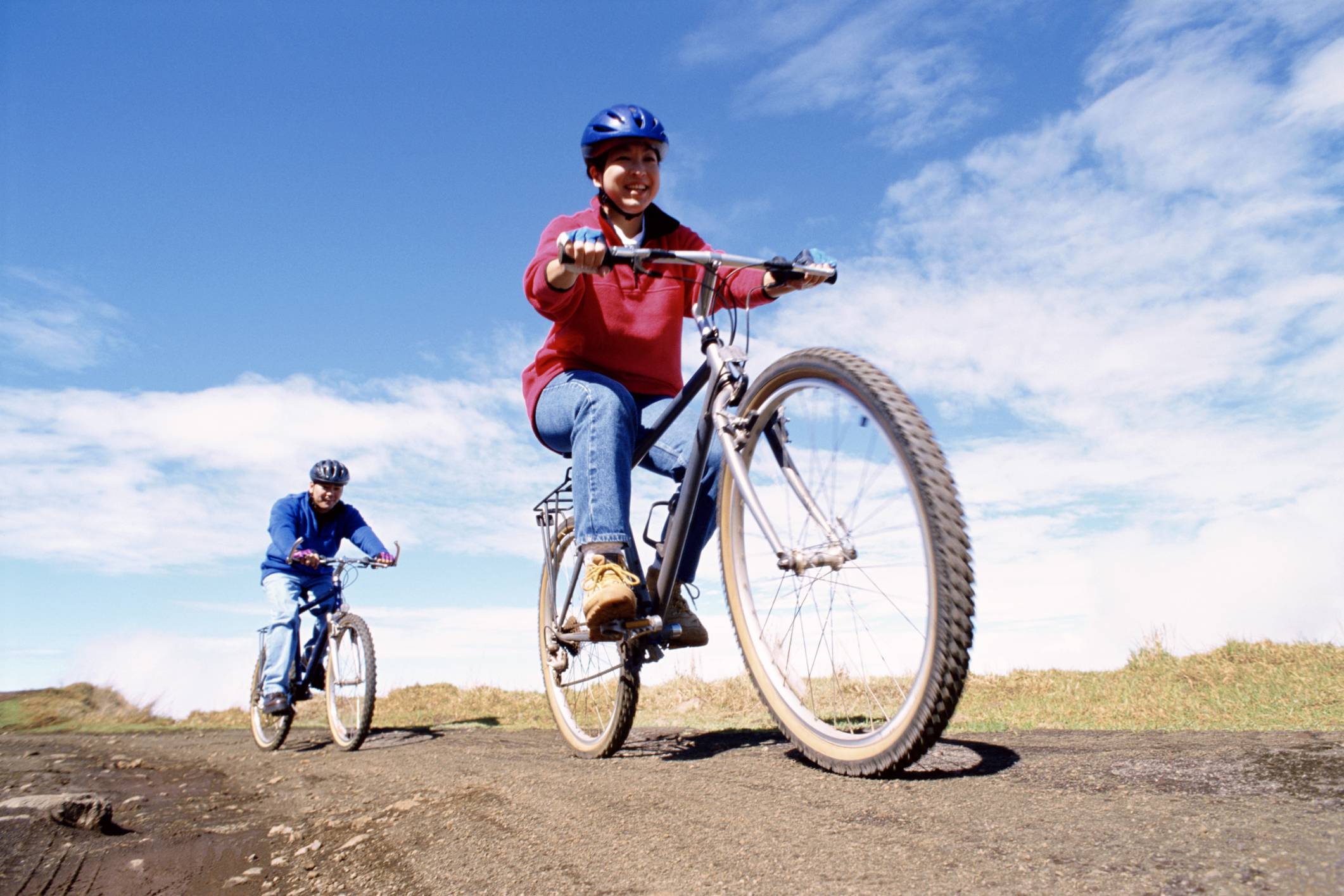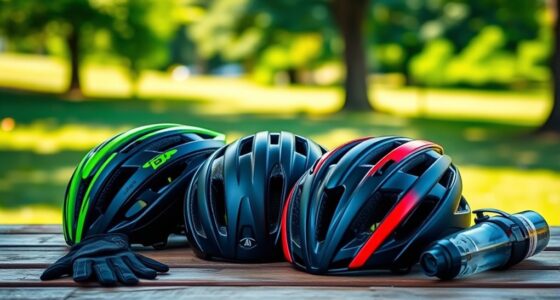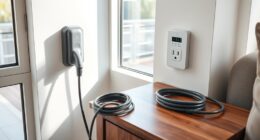Understanding cadence training zones helps you ride more efficiently and avoid common pitfalls. By targeting different zones—light recovery, aerobic, anaerobic, or sprints—you optimize your power, endurance, and muscle strength. It’s easy to get caught up in gear changes, but focusing on your cadence and using proper tools guarantees better results. Mastering these zones isn’t just about effort; it’s about smarter riding. Keep exploring, and you’ll discover secrets to elevate your cycling game even further.
Key Takeaways
- Proper cadence zones optimize efficiency, from low (strength building) to high (neuromuscular coordination), tailored to individual goals and terrain.
- Monitoring heart rate, power, and perceived exertion helps accurately identify and train within each cadence zone.
- Using cadence sensors and timers ensures consistent efforts and effective zone targeting during workouts.
- Varying cadence zones prevents fatigue, reduces injury risk, and enhances overall cycling performance.
- Personalizing cadence and training zones is essential, as ideal cadence varies based on rider, terrain, and specific training objectives.
Understanding Cadence and Its Role in Cycling

Understanding cadence is vital because it directly impacts your cycling efficiency and performance. Cadence refers to how fast you pedal, measured in revolutions per minute (RPM). When you maintain an ideal cadence, you improve cadence efficiency, allowing your muscles to work more effectively and reducing fatigue. Your pedaling technique plays a key role here; smooth, circular movements help you maximize power while conserving energy. Focusing on consistent cadence helps you develop a rhythm that enhances overall endurance and speed. If you pedal too slowly, you risk overexertion, while pedaling too fast can lead to sloppy technique and wasted energy. Mastering your cadence also involves understanding gear selection, which influences how easily you can maintain your desired pedal speed. By mastering your cadence, you fine-tune your pedaling technique, making every stroke more efficient and boosting your cycling performance.
The Different Training Zones and How to Identify Them

To identify your training zones, you’ll want to pay attention to your heart rate ranges, power output levels, and how hard you feel you’re working on the perceived exertion scale. These metrics help you gauge whether you’re riding at an easy recovery pace or pushing your limits. Understanding how to recognize each zone guarantees you train effectively and avoid overexertion. Incorporating wall organization systems with aesthetic hooks can also help keep your training space organized and motivating.
Heart Rate Ranges
Have you ever wondered how to tell if you’re exercising in the right zone? Your heart rate ranges help you identify your training intensity accurately. By monitoring your heart rate, you can stay within specific zones for ideal results. Glycolic acid benefits Skin care routines that incorporate glycolic acid can enhance skin radiance and texture, supporting your overall health and appearance.
- Light zone: 50-60% of max heart rate, ideal for warm-ups and recovery
- Moderate zone: 60-70%, improves endurance and fat burning
- Aerobic zone: 70-80%, boosts cardiovascular fitness
- Anaerobic zone: 80-90%, increases speed and power
Knowing your heart rate zones allows you to adjust your effort accordingly. Staying within the right ranges ensures you’re training efficiently, whether it’s for stamina, recovery, or performance. Tracking your heart rate gives you real-time feedback on your training intensity.
Power Output Levels
Measuring your power output provides a different way to gauge your training intensity beyond heart rate zones. By monitoring wattage targets, you can accurately identify your power zones and tailor workouts effectively. Your power zones range from recovery to maximal efforts, each with specific wattage targets. Use a power meter to track these levels precisely. Here’s a quick overview:
| Power Zone | Wattage Targets |
|---|---|
| Zone 1 | 50-60% of FTP |
| Zone 2 | 60-70% of FTP |
| Zone 3 | 70-80% of FTP |
Knowing your power zones helps optimize training, improve performance, and prevent overtraining. Focus on maintaining consistent wattage within each zone to maximize your cycling gains. Additionally, understanding tuning options for your bike can further enhance your efficiency and power output.
Perceived Exertion Scale
Understanding your perceived exertion allows you to gauge workout intensity without relying on gadgets or heart rate monitors. By tuning into how hard you feel you’re working, you can better manage your training zones. Use breathing techniques to assess effort—if your breathing becomes labored but controlled, you’re likely in a moderate zone. Recognize when talking feels challenging, indicating a higher intensity. Nutrition strategies also influence perceived exertion; proper fueling can make harder efforts feel more manageable. To identify your zones:
- Focus on your breathing pattern and fatigue levels
- Adjust effort based on how easily you can carry a conversation
- Monitor your body’s response to different cadence and terrain
- Use perceived exertion alongside other cues for ideal training insights
- Incorporating well-being tips such as relaxation and mindfulness can help improve overall training focus and recovery.
Benefits of Training in Each Cadence Zone

Training in different cadence zones offers targeted benefits that can enhance your cycling performance and overall fitness. By practicing cadence optimization, you improve your ability to maintain consistent pedaling speed, which boosts pedaling efficiency. Low-cadence training helps develop muscular strength, allowing you to power through tough climbs or sprints. Moderate cadences improve overall pedaling smoothness and endurance, making your ride more comfortable and sustainable. High-cadence work enhances neuromuscular coordination and can reduce fatigue over long distances. Each zone offers unique advantages, ensuring you develop a well-rounded skill set. Incorporating varied cadence training helps prevent burnout, reduces injury risk, and makes your cycling more efficient, whether you’re climbing hills, sprinting, or maintaining steady pace on long rides. Understanding the best anime movies and animated films that touch hearts can also provide a refreshing mental break during training routines.
Common Myths About Cadence Training Debunked

Many cyclists believe that there’s a one-size-fits-all ideal cadence, but this isn’t true. Cadence myths and training misconceptions often lead riders to chase an “optimal” number that doesn’t suit their body or goals. In reality, your ideal cadence varies based on fitness, terrain, and riding style.
Many cyclists mistakenly chase a universal cadence, but it varies for everyone.
- Higher cadences aren’t always better; they can cause fatigue if not trained properly.
- Lower cadences aren’t inherently inefficient; they can be effective for strength.
- The myth that you must always pedal at a certain cadence ignores individual differences.
- Focusing solely on cadence can distract from overall performance and efficiency.
- Proper tuning of your cycling training zones ensures you optimize your cadence for your specific needs.
Understanding these training misconceptions helps you develop a more personalized approach and avoid unnecessary limitations.
How to Incorporate Cadence Zones Into Your Routine

Start by setting clear goals for your cadence training to stay focused and motivated. Use a timer to keep track of your intervals and guarantee you’re maintaining the right zones. Track your progress regularly to see improvements and make adjustments as needed. Incorporating nutritional strategies such as hydration and balanced intake can further enhance your training effectiveness.
Set Clear Goals
Have you clearly defined your cadence zone goals before integrating them into your routine? Setting specific targets helps you stay focused and track progress. Decide if your aim is to improve cadence consistency, pedal stroke efficiency, or endurance. Clear goals give your training purpose and guide your zone selection.
Additionally, understanding your training zones can optimize your efforts and prevent overtraining.
Use a Timer
Incorporating a timer into your cadence training helps you stay focused on your goals and maintain consistent effort within your targeted zones. It’s essential for effective interval training, ensuring you switch between high and low cadence phases accurately. Use a timer to structure sessions, so you don’t drift out of your desired zone. Here’s a simple guide:
| Cadence Zone | Duration |
|---|---|
| Warm-up | 5 minutes |
| High cadence | 1-2 minutes |
| Rest/low cadence | 2-3 minutes |
| Repeat cycles | 3-4 times |
| Cool-down | 5 minutes |
This approach boosts cadence consistency, helping you build stamina and improve overall cycling efficiency. A timer keeps your workouts disciplined and effective.
Track Your Progress
How can you effectively track your progress when integrating cadence zones into your routine? The key is maintaining cadence consistency and adjusting gear selection as needed. Use a cycling app or wearable device to log your cadence, noting improvements over time. Regularly review your data to identify trends and areas for improvement. Focus on setting achievable goals within each cadence zone to stay motivated. Additionally, track how your gear shifts influence your cadence, ensuring smooth progressions. Incorporate these strategies to stay accountable and make informed adjustments. By paying attention to your cadence consistency and gear choices, you’ll see measurable progress and build better cycling habits. Monitoring training metrics can provide deeper insights into your performance and help you optimize your training plan. This approach helps you fine-tune your training and reach your performance goals more efficiently.
Tools and Techniques for Monitoring and Improving Your Cadence

Monitoring and improving your cadence requires the right tools and techniques to track your performance accurately. Using cadence sensors on your bike provides real-time data, helping you stay within your target zones. Interval timers are also valuable for structuring training sessions, allowing you to focus on specific cadence ranges. To visualize your options, here’s a quick overview:
| Tool | Technique | Benefit |
|---|---|---|
| Cadence sensors | Real-time cadence feedback | Precise, immediate adjustments |
| Interval timers | Structured workout sessions | Focused zone improvement |
| Smartphone apps | Data analysis & tracking | Long-term progress monitoring |
| Bike computers | Multi-data display | Easy, on-the-go insights |
Combine these tools and techniques to refine your cadence effectively and enhance your cycling performance.
Frequently Asked Questions
How Does Cadence Training Affect Cycling Efficiency Over Time?
Cadence training boosts your cycling efficiency over time by improving pedal smoothness and promoting muscle adaptation. As you train at ideal cadences, you develop more fluid pedaling, reducing wasted energy. Your muscles become more efficient at sustaining higher cadences, leading to better endurance and power output. Consistent cadence training helps you ride more smoothly, conserve energy, and perform better on long rides or intense efforts.
Can Cadence Zones Be Different for Road Bikes Versus Mountain Bikes?
Think of your bike as a musical instrument, and cadence zones as different melodies. Yes, they can vary between road and mountain bikes because gear preferences and pedaling biomechanics differ. Road bikes often favor higher cadence for speed, while mountain bikes might need lower, more controlled pedaling for technical terrain. Adjusting your cadence zones helps optimize performance, comfort, and efficiency for each riding style.
What Role Does Cadence Play in Preventing Cycling Injuries?
Cadence plays a vital role in injury prevention by promoting pedal smoothness, which reduces unnecessary strain on your knees and hips. Maintaining an ideal cadence allows you to avoid overexertion and muscle fatigue, lowering injury risk. By focusing on steady, controlled pedaling, you improve efficiency and protect your joints, making your rides safer and more comfortable. So, keep a consistent cadence to safeguard your body during every cycling session.
Are There Specific Cadence Targets for Different Cycling Disciplines?
You should aim for specific cadence targets tailored to each cycling discipline. For road cycling, maintain a pedal rhythm of 80-100 RPM with smooth gear selection for efficiency. Mountain biking often requires a slightly lower cadence around 70-90 RPM to handle technical terrain. Track cycling prefers higher cadences, around 100+ RPM. Adjust your gear selection to match the terrain and discipline, ensuring a smooth, efficient pedal rhythm that minimizes fatigue and maximizes performance.
How Does Cycling Experience Influence Optimal Cadence Zone Selection?
Imagine gliding smoothly along a quiet trail; your cycling experience shapes your ideal cadence zone. With more experience, you naturally fine-tune your cycling biomechanics, allowing you to maintain a higher cadence comfortably. Less experienced riders might find a lower cadence reduces rider fatigue and enhances control. Your familiarity with your body’s responses helps you choose the best cadence zone, improving efficiency and preventing premature fatigue during rides.
Conclusion
Think of your cadence as the rhythm of a song you’re composing on your bike. When you find the right tempo in each zone, your ride flows smoothly, like a melody that energizes and sustains you. By mastering these rhythms, you become the conductor of your cycling symphony, steering hills and sprints with confidence. Embrace these zones, fine-tune your performance, and turn every ride into a harmonious journey.









